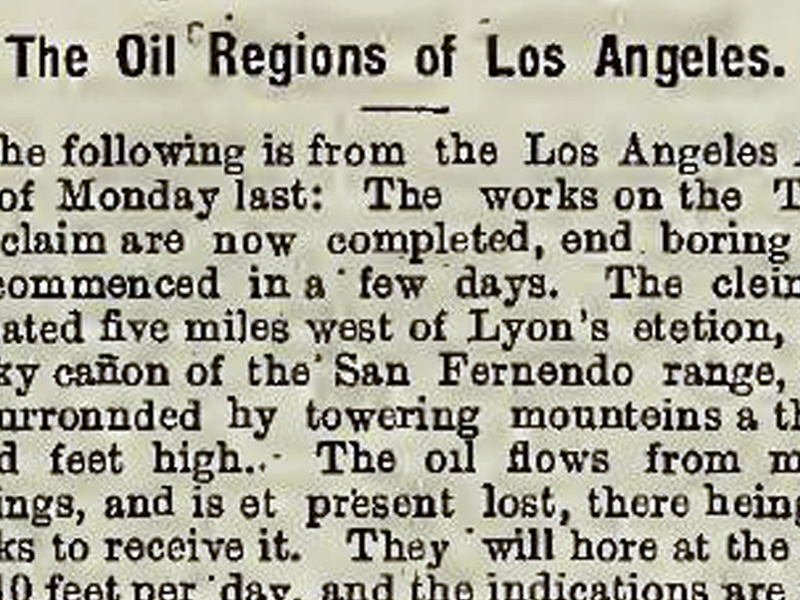|
|
31. Rivers of Oil
|
Along the southern rim of the Santa Clarita Valley, in canyons called Placerita, Elsmere, Wiley, Towsley and Pico, petroleum has oozed from rocky fissures for aeons. Indians and later Spaniards skimmed these pools, using the black, gooey substance for medicinal purposes and to waterproof baskets. Other than that, oil did not seem much good for anything. In 1855, Gen. Andres Pico began hauling "asphaltum" down from the canyon that now bears his name to Rancho San Fernando. Four years later, the world's first oil well, in Titusville, Pennsylvania, gave birth to what would one day become the gigantic oil industry. Dr. Vincent Gelcich, a Los Angeles chemist, sampled seepages in the canyons of the Santa Clarita Valley and advised his friends to invest in the area. Henry Clay Wiley, expressman and merchant, skimmed the pools in Wiley Canyon. Sanford Lyon invaded what is now Lyon Canyon. Other draws were named for Dr. Rice, Christopher Leaming and Darius Towsley. Dr. Gelcich became the biggest investor with his Santa Clara Oil Company, centered in Pico Canyon. With the 1864 publication of Professor Silliman's Rivers of Oil, eastern interests began to look to California as a second Titusville. Thomas A. Scott, for example, purchased Rancho San Francisco with oil exploration in mind. Several wells were drilled there, but none was successful. Another man read the professor's report and decided that a second opinion was in order. This was none other than General Edward F. Beale, master of Tejon. With the help of a Dr. Aslop of Harvard University he inventoried one hundred claims in Pico Canyon, then decided to gobble them up. Beale quickly joined forces with Generál Pico, his old foe from the Battle of San Pasqual, along with Dr. Gelcich and others, to form the Los Angeles Asphaltum and Petroleum Mining District. On June 24, 1865, three months after the creation of this district, the group set up the San Fernando Mining District. This was a clever arrangement. In essence, the first board was created to sort out the many conflicting claims, while the second existed to buy up the patents that the first board had ruled invalid. The first thing they did was grant to Andres Pico the naphtha springs claim in Pico Canyon. This was done by back-dating the claim to Jan. 24, 1865, three months before the L.A. Asphaltum and Petroleum Mining District was formed. Then the claim of H.C. Wiley was approved. Wiley, incidentally, was Generál Pico's son-in-law. With that done, the claim of Perea and Hernandez was ruled invalid by L.A. Asphaltum and signed over to San Fernando Petroleum on May 22, 1865. Through the agency of Christopher Leaming, Beale and his partners — Col. Robert S. Baker, Wiley, Pico and others — moved in on the holdings of ninety-one grantors. On Aug. 7 the ink was blotted on a deed in exchange for three hundred dollars. Beale and his associates now controlled everything between the Santa Clarita and San Fernando valleys — in the "no-man's land" that belonged neither to the San Francisco nor the San Fernando rancho. Crude oil was skimmed from the pools, poured into leather sacks, slung on the backs of mules and hauled downstream to the port at Ventura. There, coastal steamers picked up the cargo and sailed north to the city of San Francisco, also carrying shipments of cattle, grain, passengers or whatever freight was available. As the Industrial Revolution had not yet made its appearance in California, oil was used to grease wagon wheels and perform other lubrication chores, but it was mainly refined into kerosene. Late in the year, Beale, Baker, Pico, Lyon and Juan and Francisco Forester founded the first Star Oil Works company in order to build a refinery that used a process developed by Dr. Gelcich. ©1998 SANTA CLARITA VALLEY HISTORICAL SOCIETY RIGHTS RESERVED. |
• Reynolds Story
Hughes Claim 1865
Letter from Leaming to Beale 7-3-1866
Spring Pole Demonstration 1997
|
The site owner makes no assertions as to ownership of any original copyrights to digitized images. However, these images are intended for Personal or Research use only. Any other kind of use, including but not limited to commercial or scholarly publication in any medium or format, public exhibition, or use online or in a web site, may be subject to additional restrictions including but not limited to the copyrights held by parties other than the site owner. USERS ARE SOLELY RESPONSIBLE for determining the existence of such rights and for obtaining any permissions and/or paying associated fees necessary for the proposed use.


